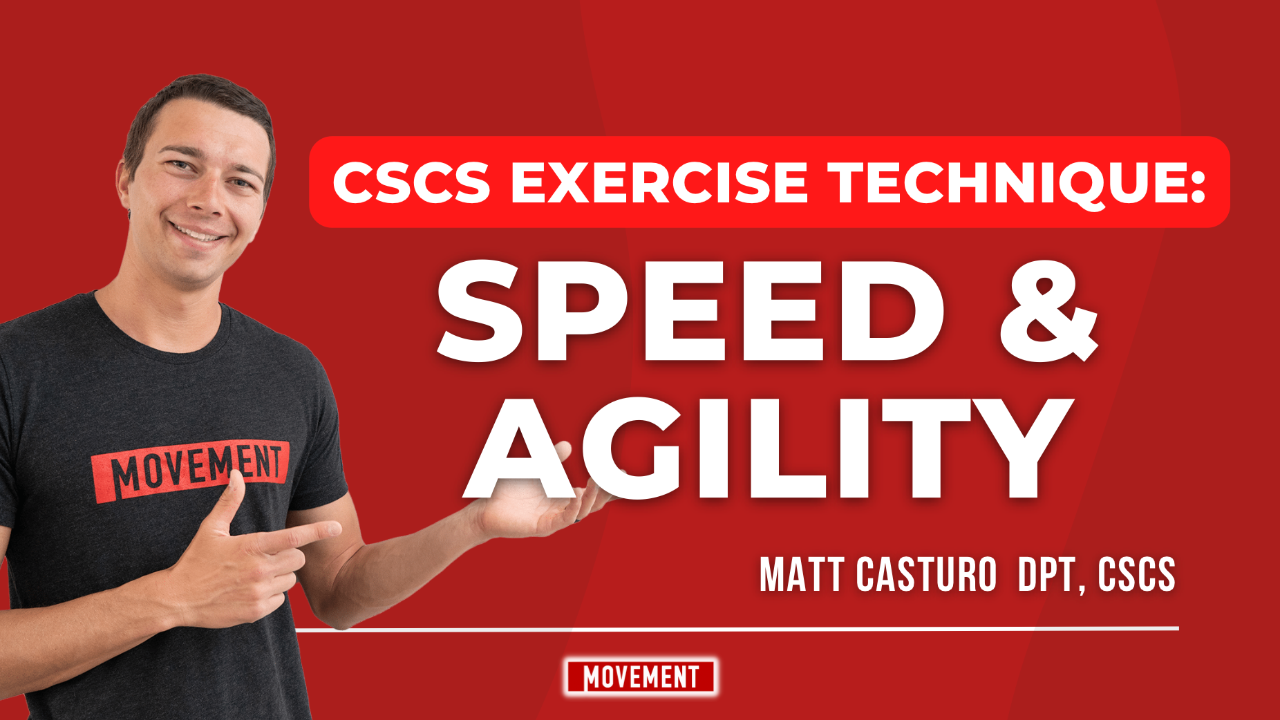CSCS Exercise Technique for Speed & Agility
Jul 19, 2023
Edited by: Danielle Abel
It's hard to come by exercise technique study prep material for the practical applied section of the CSCS exam, so in this article, we want to give you some tips on exercise technique when it comes to speed & agility.
In this article, we'll go through some common mistakes to look for and coaching adjustments you can offer to improve your athlete's performance.
When it comes to exercise technique overall, knowing the proper movement technique along with cues or adjustments you can use with athletes is key. The book does a nice job of offering proper movement technique, but sometimes is a bit lacking, we feel, in how to coach or cue up changes for your athletes.
Sprinting
If you work with sprinters, soccer players, baseball players, football players, or even volleyball players, you'll know that sprinting and change of direction are heavily involved in these sports. As a result, you can help your athletes improve their performance by being aware of some of more common technique errors they may be making that might be holding back their progress.
Acceleration Body Position
One of the most common errors when sprinting is allowing the hips and torso to rise too early. If this happens, the body isn't as efficient at producing force into the ground downward and horizontally, which contributes to the speed of the body moving forward.
- Upright hips & torso, too early, slow you down
You'll want to help athletes keep their body lower to the ground for as long as possible. Ideally, keeping their body at 45 degrees to the ground for as long as possible.
- Using a PVC pipe or broom/broom handle can be a good visual to show athletes the angle you're looking for
Knee Drive
Another common error when sprinting that athletes make is bringing the knee up too much. What we mean by this is that the knee should just barely rise off the ground when it's coming forward in the sprinting position. If the knee comes up too high (up towards the sky/ceiling), this wastes a lot of energy and contributes to a slower sprinting speed.
- The knee should come forward, but not up much
A drill you can work on with your athletes is attaching a thin resistance band around their ankle and having them practice bringing the foot and knee forward without bringing it up.
- The band will fall off their foot if they raise the foot and knee up too much
Neck Position
From the starting blocks until about 20 meters, keeping the neck in alignment with the spine can help with speed as well. If the neck hyperextends, the body will want to go with it (where the head goes, the body goes)
- A good cue to use here is teaching them to keep their chin tucked as long as possible; this will also help them be faster
Change of Direction
The goal of change of direction efficiency is to move the body as fast and as efficiently as possible between 2 locations. Athletes who are fast with change of direction possess some key characteristics in their movement that we'll discuss below.
Turning the Head Quickly
You want athletes to turn their eyes and head quickly; as a result, the body will follow through more quickly. One way you can practice this with athletes is by using a variety of different cues with them:
- Visual cues like cones, a balloon, or another teammate
- Auditory cues like commands, horns, or whistles
Work with athletes on aligning their hips and their chest to be able to produce force quickly and more forcefully into the ground to move the body from one position to another.
Drop Center of Mass
If your athlete is sloppy with dropping their center of mass, they'll be wasting energy by not aligning the forces from their body well. As a result of not aligning forces, they will be slower.
- Cue athletes to drop one shoulder down first, followed by the other
If you align the eyes and head, followed by the shoulders, the hips are the next to follow through and bring the body forward into the new direction.
Short Choppy Arms
The arms move with the legs, so the more intentional your athletes can be with their arm mechanics & associated propulsion, the faster they will be too.
- Help athletes get the elbows behind the body, and try to get their arms through the full range of motion to be more powerful
Deceleration Mechanics
Slow eccentrics in the gym don't have much carry-over into sprinting and change of direction performance for sport. Athletes need to work on sport technique for skill development as well. You can help athletes improve their deceleration mechanics by slowly progressing them from longer to shorter deceleration distances.
- Run at half speed, then decelerate to stop within 3 steps
- Run at three-quarter speed, then decelerate to stop within 5 steps
- Run at top speed, then decelerate to stop within 7 steps
Support & Courses Available
Ready for more support to help you prep for the CSCS exam? Join our Facebook Group, “Strength and Conditioning Study Group,” here. Ready for even more? Our 24-module CSCS Prep Course has exercise technique for all sections covered on the exam completely laid out for you with even more content than what we’ve provided here, plus chapter quizzes to help you pass the NSCA exam; click the link here to check it out.
Stay connected with news and updates!
Join our mailing list to receive the latest news and updates from our team.
Don't worry, your information will not be shared.
We hate SPAM. We will never sell your information, for any reason.

